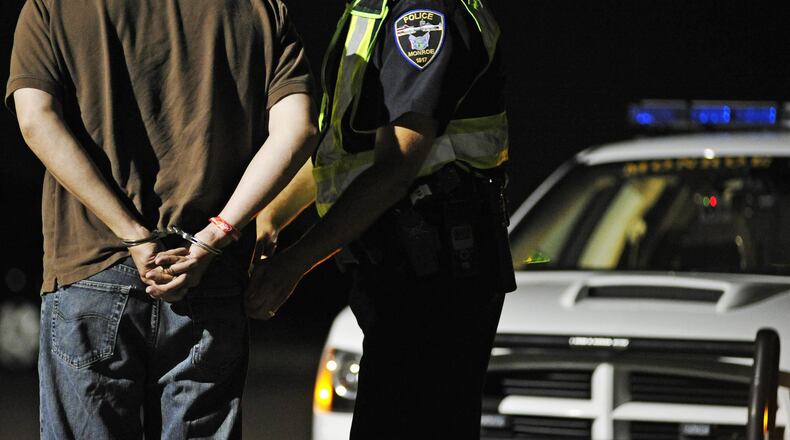Drinking and driving is a bad decision that can lead to legal troubles that cost a lot of money, cause a lot of headaches and hardship and carry heavy consequences.
"DUI will ruin your life," said Charles Rowland, a DUI defense attorney with DaytonDUI.com.
“It’s a dumb decision, it costs you a great amount of money and you have meet people like me.”
MORE: Judges assigning fewer ‘party plates’ in Ohio
In 2019, the Ohio State Highway Patrol arrested 22,518 drivers for operating a vehicle while intoxicated in Butler, Champaign, Clark, Greene, Miami, Montgomery and Warren counties, according to patrol data obtained by the Dayton Daily News.
Arrests declined 19% overall in the region, but some individual counties saw much larger declines.
Troopers made 219 arrests in Greene County (down 44%) and 158 in Miami County (-47%).
Arrests fell 17% to 653 in Montgomery County and 13% to 647 in Warren County.
Butler County had 510 arrests, 17 fewer than in 2018.
The data only captures state patrol arrests and does not include those from city, county, township, village and other local police agencies.
MORE: Millions of products must go at Mendelsons before closing
OVI arrests trend up and down, and there were high numbers of arrests in 2016, 2017 and 2018, said Staff Lt. Craig Cvetan, public affairs commander with the state patrol.
The state patrol uses data to drive enforcement, and impaired driving will always be a main focus arra since it has such a big impact on the safety of the roadways, he said.
But there are other kinds of dangers and risks on the road like distracted driving, unsafe speeds, failure to yield and seat belt usage, and each post commander looks at trends in their coverage areas and makes decisions about targeted enforcement, he said.
Impaired driving is 100% preventable, and the state patrol uses enforcement and education to try to convince motorists to make the responsible decision to not drive impaired, Cvetan said.
“As long as there are still those who choose to drive impaired we will be working to get them off the roads,” he said.
Motorists have more options than ever before for finding an alternate method of travel when they have been drinking, including ride-share companies like Uber and Lyft, Cvetan said.
Rob Healey, a criminal defense attorney with Suhre & Associates in Dayton, said he does not think people are drinking and driving any less.
“In fact, I am as busy as ever,” he said.
PHOTOS: See some of the Dayton flag submissions
But he said the volume of OVI calls he receives fluctuates, and his theory is that weather might play a role.
People don’t want to drink outside the home if it gets too hot or too cold or it’s nasty outside, he said.
Still, he doesn’t think weather alone explains the decrease in arrests.
He said law enforcement’s decisions are a big factor, and he’d like to see the figures on use of “saturation patrols,” which are when police have a heavy presence focused on specific crimes, like OVIs. He said he thinks they are more effective than checkpoints.
Healey said intoxicated drivers usually get caught for small traffic violations, like speeding, not staying in marked lanes, stopping over the stop bar at a red light or wide or narrow turns.
He said they are rarely caught after crashing their cars.
But impaired driving increases the likelihood of auto accidents, law enforcement officials say, and last year there were 1,823 OVI-related crashes in the seven-county region.
MORE: Some neighbors don’t want Grandview to land helicopters
Though OVI arrests declined significantly, OVI crashes in the region were down less than 1% compared to 2018.
Aside from increasing the risk of automobile crashes, OVIs can lead to jail time, license suspensions, possible forfeiture of the motor vehicle and costs including fines and fees for court costs, license reinstatement, alcohol treatment programs and attorney bills, said Gary Hruska, an attorney with Holzfaster, Cecil, McKnight & Mues, LPA in Dayton.
“These costs can easily amount to thousands of dollars,” he said. “In addition, an OVI conviction usually results in an increase in insurance rates or even termination of your auto insurance. An OVI conviction can also affect your employment.”
OVI arrests likely fluctuate from year to year due to the level of enforcement actions, Hruska said.
OVI arrests related to prescription medication have been increasing, said Michael Mills, attorney with Denny & Mills Law Office in Dayton, who added that these defendants are likely to become a larger part of his client base.
These defendants face the same penalties as those arrested for traditional “drunk driving,” even if they have a valid prescription for their medication, he said.
Once the state introduces an “expedient” way to field test for marijuana in drivers’ system, more people will be arrested for OVI, he said.
“Marijuana arrests for OVI are currently hampered by technological limitations,” he said. “A causal user of marijuana is likely to have enough THC metabolite in their system at any given time to fail a urine or blood test irrespective of whether they were actually under the influence of the drug when they were driving.”
OVI arrests, crashes by county in 2019
County, OVI arrests (% change from 2019), OVI-related crashes
Butler: 510 (-3%), 407
Champaign: 4 (-67%), 34
Clark: 519 (-14%), 206
Greene: 219 (-44%), 192
Miami: 158 (-47%), 136
Montgomery: 653 (-17%), 595
Warren: 647 (-13%), 253
Source: Ohio State Highway Patrol
About the Author

